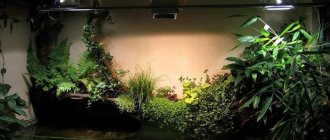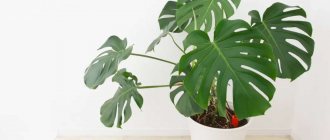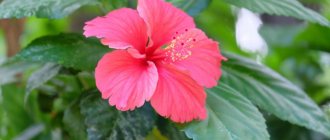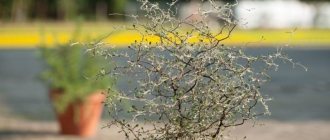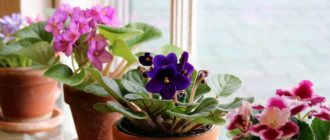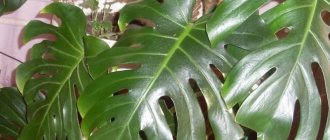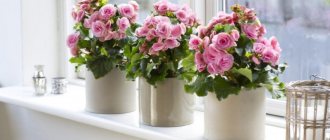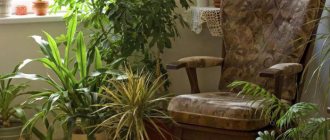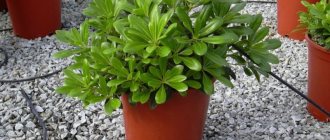The amount of light is a factor of paramount importance for flora. Shade-loving indoor plants are less demanding on lighting, which makes them indispensable in the interior. They remain decorative even with a lack of light, and easily transform dark corners of an apartment or office into green “oases.” The choice of potted plants for the hallway, bathroom, corridor, and rooms facing north should be especially careful. Read about which indoor plants require little light and what you should consider when caring for them.
General recommendations when choosing shade-loving plants
Almost all indoor flowers develop best in good light, but vary in their ability to tolerate bright sun and shade.
There are no plants that don't need light! It is a source of energy for photosynthesis, a “power button” for biorhythms and other processes in the body. But there are many representatives of the flora that are accustomed to living in conditions of significant shading.
Are the chosen plants suitable for your space or will they suffer from lack of light? Let's figure out what kind of lighting different indoor flowers require.
Light-loving, light-loving (heliophytes)
Such plants tolerate only a slight lack of sunlight. For normal growth and development, they require illumination of 1000–5000 lux (lx) and above. When illumination is below 700 lux, a period of rest begins. These include most succulents, citrus fruits, hippeastrum, zephyranthes, aechmea and many others.
Shade-loving or shady
In nature, such plants live in shady conditions - in the lower tier of the tropical forest, in the shade of large trees and shrubs. The leaves are relatively large, arranged horizontally, contain more chlorophyll and are able to photosynthesize in dim light.
Shade-loving indoor plants develop better in the shade and do not tolerate strong lighting from direct sunlight. This group includes some lianas, large-leaved begonias, and many commelinaceae.
Shade-tolerant (facultative heliophytes)
An intermediate group, including species that can grow in good light, in open shade, partial shade. There are quite a lot of them. These are some aroids, arrowroots, palms, chlorophytums and many other indoor flowers - moderately shade-tolerant, they require illumination of 400-500 lux (minimum 200, maximum 3000 lux).
Monstera, sansevieria, ivy and some other plants develop well in normal lighting conditions, but can also tolerate darkening. They are able to rearrange themselves under the influence of changes in the amount of light.
Required lighting
No indoor plant can grow in complete darkness. Without light, photosynthesis processes do not occur in it, it withers and dies. If you want to refresh your room with live flora, you have two options:
- Take plants out for walks;
- Provide artificial lighting;
- Change plants periodically.
The best option is to remove plants from the bathroom every day. For example, before leaving for work, school or going to the store, take out the pots and flowerpots and place them on the windowsills. And when you return, return them to the bathroom.
Important
In this publication we have given examples of shade-loving indoor plants. Most of them are afraid of direct sunlight. Therefore, place them on the western, northern or eastern side of the house or apartment.
For constant lighting, you can use phytolamps, special LEDs or LED panels. They are designed to illuminate indoor plants and seedlings, providing light as close as possible to sunlight. This is a good solution, but the main problem is choice. You can read about the types of phytolamps and their selection here.
Some believe that phytolamps are ineffective and this is a simple deception of buyers. Actually this is not true. All over the world, they are used to grow vegetables and berries in greenhouses in winter. In terms of taste, they do not differ from ordinary ones and are much better than greenhouse ones. The main thing is to buy high-quality phytolamps from trusted suppliers.
There are plants that can survive for long periods without sunlight. They do not die from its lack, but begin to develop more slowly. You can plant two “sets” of such flora. Some will stand in the bathroom, while others will be on the windowsills. You will need to swap them every few days.
Decorative foliage shade-loving plants
Gardeners are familiar with the names of shade-loving indoor plants. These are popular and in demand decorative deciduous crops.
If there is no desire or need to remember the names, then it is enough to remember a practical tip: plants with dark green flat leaves usually cope better than others with a lack of light.
The bright green color is the result of high chlorophyll content. The darker the leaves, the less they need bright light for photosynthesis, the darker the possible location. The most shade-tolerant indoor plants are placed 2 m from northern ones, 3 m from windows of a different orientation. They are suitable for creating green walls and corners in living rooms, halls, and offices.
Alocasia
Alocasia is a plant of the Araceae family. The popular name is “elephant ear”. Characteristic features of the flower: dense leaves, bright veins, long succulent petioles.
The flowers are small, inconspicuous, and appear rarely. Alocasia is not demanding both in terms of lighting conditions and care. The species A. copper-red and A. amazonica require additional lighting in winter.
Aucuba japonica
The plant received the popular name golden tree due to its shiny, leathery leaves. Aucuba grows well in partial shade and in diffused bright light. Green-leaved forms are shade-loving and resistant to changes in air temperature.
Shady places are not suitable for varieties with variegated foliage; they lose their characteristic pattern.
Aglaonema
Aglaonema modestus is a plant similar to Dieffenbachia, but smaller in size. The leaves are green or with multi-colored stripes and spots, with a clearly visible midrib.
Species and varieties with pure green leaves are the most shade-tolerant. They grow well indoors. Plants with variegated leaves need bright, indirect light.
Royal Begonia or Rex
It’s hard not to pay attention to this spectacular indoor plant with large leaves and a fantasy pattern. The leaf blades are asymmetrical and shaped like a heart.
The color above is silver-green, olive, below - purple, violet, dark pink. The dots and strokes are white or silvery. In a bright place, protected from direct sunlight, Rex begonia grows as a compact bush and stretches out in the shade.
Gemaria
Gemaria versicolor or Ludisia is an orchid with decorative leaves. The shape of the leaf blades is oval, the color is green-brown with white or silver veins.
The lower surface is red. Small yellow-white flowers bloom at the tops of the shoots. Gemaria is valued more for the beauty of its leaves than for its blooms. The plant feels great on the windowsill of a north window. In winter, it is advisable to supplement the light with a phytolamp.
Dracaena
Plants are valued for their exotic appearance and the beauty of their lush rosette of leaves. There are a large number of species with green leaves, such as Dracaena marginata. If you look closely, you will notice that the coloring is not the same. There is a thin red stripe along the edge of the leaves.
Dracaenas with solid green leaves are especially suitable for partial shade. However, the beautiful white, yellow, and red stripes of variegated varieties look more expressive in diffused bright light. Dracaena fragrant (Fragrans) can grow in partial shade. In a green corner, dracaenas are harmoniously combined in appearance and care requirements with chlorophytums, dieffenbachia, and palm trees. These plants require similar lighting conditions.
Maranthaceae
The group includes 4 species of plants: Maranta, Calathea, Stromantha and Ctenanta. They are true tropical beauties with variegated leaves. The plates have silvery or red veins. The lower surface of the leaves is purple, burgundy or violet.
Maranths look spectacular in semi-shaded corners of rooms, on the windowsills of northern windows, and under artificial lighting. Velvety leaves do not tolerate direct sunlight.
Fern phyllitis
An exotic plant suitable for living rooms, bedrooms and bathrooms. All types of ferns in nature and indoor culture have a common feature - they do not bloom. The natural habitat of these representatives of the flora is shady places under trees, on trunks. Phyllitis or Leaflet differs from many other ferns in its entire fronds (leaves). Forms with a wavy edge of the leaf blade were created.
The plant is kept in a shady place, for example, on the windowsill of a north window. Other indoor ferns are also resistant to lack of light: nephrolepis, long-leaved bracken.
Sansevieria
A houseplant with tough, striped leaves thrives in a shady location. Sansevieria looks decorative all year round, rarely gets sick and is practically not damaged by pests. The plant can reach a height of 1–1.5 m, so it is planted in wide, stable floor flowerpots or containers.
Low-growing varieties are more demanding and require a bright location. The brighter the stripes, spots and borders on the leaves of Sansevieria, the more light the plant requires.
Ficus dwarf
Tolerant of low light, fast-growing indoor flowers are ideal for rooms with artificial lighting. Ficus ampelous dwarf - a group of plants for the hallway. There are green-leaved and variegated varieties, and cultivated forms with wavy leaves.
Although dwarf ficus is considered shade-tolerant, modern variegated varieties require a little more light. When shaded, bright stripes and spots fade. But hanging ficuses can be content with artificial lighting.
Zamioculcas
A spectacular plant with long, thick branches and dense leaves, which is commonly called the dollar tree, grows well in partial shade.
The ideal place for this plant is a meter away from a south or south-east window. The flower also agrees with living on the northern, northeastern and northwestern windowsill. Zamioculcas even blooms in such conditions.
Monstera
The large plant attracts attention with its carved leaves, long aerial roots, and winding stem. Monstera does not tolerate the scorching sun, especially suitable for shady places.
Compact, variegated varieties of this crop are popular: “Borziga”, “Variegata”, “Alba”. Monsteras with variegated leaves are more sensitive to lack of light. In the shade, white, silver or golden spots disappear.
Chlorophytum
The plant is considered shade-loving, one of the most stable, unpretentious to living conditions.
The long narrow leaves of chlorophytum tolerate partial shade and bright light. In the second case, you need to take care of regular watering. An indoor flower in good conditions grows quickly, shoots out arrows with small white flowers and daughter rosettes. Chlorophytum looks especially attractive on a shelf and in a hanging pot.
Hamedorea
The indoor plant is considered the best among palm trees for placement in a house or apartment. Hamedorea is an elegant multi-stemmed shrub 1–1.5 m high. The shoots are beautifully curved, evenly leafy.
The entire shrub seems openwork thanks to the luxurious feathery leaves. The male inflorescences resemble mimosa. After pollination, small black fruits form on the red peduncles of female flowers. In nature, chamedorea grows in the shade of large trees, so it likes diffused light.
Fittonia
The attractive flower is one of the capricious houseplants. Fittonia is difficult to please in terms of lighting and moisture. Sissy grows better in paludariums, phytoterrariums or florariums.
If there is not enough light or it is too bright, then Fittonia loses its bright color. The plant is more suited to places with good artificial lighting than to natural ones.
Indoor large sizes. Palm trees
You can diversify your interior or add a touch of exoticism to your home atmosphere with the help of decorative palm trees or large trees. However, in most cases this is a costly affair and requires painstaking work to create special climatic conditions for the germination of exotic plants at home. Large-sized and indoor palms do not tolerate frequent transplants and drafts. For those who do not have the time to look after and provide proper care for such plants, it is recommended to purchase unpretentious varieties. There are several of the most popular types.
Hamedorea
The plant takes root in any home climatic conditions, does not require excess light and other factors, since it can grow in the proposed conditions.
Advantages:
- no need to think about transplantation, it is necessary no more than once every 1-1.5 years.
Flaw:
- In order for the palm tree to gain growth, intensive watering is required at a certain growth phase.
Howea Forster
Externally, it has larger leaves and stems than chamedoria.
Advantages:
- unpretentious;
- can withstand drought.
Flaw:
- if growth is needed, then the howea must be irrigated and fed constantly.
Dangerous house flowers
Some types of flowers can release toxic substances to pets and can also be dangerous to people. Despite the warnings, many people safely keep such plants at home.
- Philodendron (dangerous for cats; if an adult or child eats a piece of the plant, minor side effects will occur);
- Syngonium (causes vomiting in humans and animals if a piece is eaten);
- Spathiphyllum (the most dangerous type of flower, if it gets into the stomach it causes serious consequences);
- Dieffenbachia (causes mild symptoms of poisoning).
Blooming shade-tolerant houseplants
When choosing flowering plants for the home, many people have to give preference to flowers that love shade or tolerate shade without problems. We present a brief description, names and photos of the most popular species that bloom profusely in low light conditions.
It should be remembered that flowering shade-tolerant plants do not form buds and flowers in the shade. They require diffused lighting or light shading.
Among this group there are species that bloom in November or December. Most begin flowering in spring or summer with long daylight hours. Before budding and during flowering, it is not recommended to move or rotate pots with plants.
Azalea
This flower is often called rhododendron. Azalea is considered one of the most beautiful indoor plants.
It likes cool places and blooms in the winter months. The flowers are double or simple, the petals are painted in delicate tones with a predominance of pink and salmon. Corollas can be red, purple, white and variegated. Azaleas require diffused light, without direct sunlight.
Vriesia
There is another variant of the name of the plant - “friesea”. The flower belongs to the group of epiphytic bromeliads. The leaves are collected in a rosette, the center of which looks like a bowl. Vriesia blooms once in a lifetime, but very impressively.
A spear-shaped inflorescence blooms on a long peduncle. The bracts are brightly colored. They can be red, yellow, orange, two or three colors. Vriesia prefers places with diffused lighting. Completely shaded or too sunny locations are not suitable.
Calceolaria
This amazing, original house plant resembles an orchid with its bold colors. Calceolaria prefers cool rooms, feels good in diffused light, in openwork shade.
Often the flower is grown as an annual. In the first year the flowering is abundant, but in the subsequent season the decorative effect decreases. It is possible to extend the “age” of Calceolaria by ensuring it is kept cool in a bright place.
Clivia cinnabar
An easy to care for houseplant with large, bright flowers. Clivia's narrow, dark green leaves form a fan-shaped rosette. The flower arrow appears in mid or late February. At the top of the green “tube” a dense racemose inflorescence blooms. The flowers are funnel-shaped and colored in red-orange tones.
Clivia prefers bright, diffused light. The bush does not lose its decorative appearance in the shade, but then it blooms less often.
Lady's slipper orchid
The scientific name of this genus of orchids is paphiopedilum, which means “slipper.” Flowers bloom on peduncles up to 60 cm high.
P. appletona is considered shade-tolerant and comes from Southeast Asia. The leaves of Lady's slipper are narrow and long, bright green with a marbled pattern. The flowers are large (up to 10 cm), with a corolla decorated with lilac-violet dots and strokes. To flower, the plant requires diffused lighting, 12 hours of daylight.
Saintpaulia
Violet fits perfectly into the interior of a bedroom, kitchen, or office. The correct name of the plant is Saintpaulia violetflower. Small bushes bloom profusely almost all year round (with interruptions).
Violet loves light, but does not tolerate direct rays. The sun leaves burns on the velvet leaves, shortening the flowering period and life of the plant. Saintpaulia is suitable for diffused lighting on the windowsill of windows facing east and north-west.
Spathiphyllum
Spathiphyllum forms an inflorescence-cob surrounded by a bract leaf. Beautiful appearance and low maintenance requirements are the main reasons for the popularity of this plant.
Shade-loving flowers feel comfortable on northern, eastern or western windows. In summer, at midday, it is necessary to protect the leaves from direct sunlight. Spathiphyllum is ideal for shady corners of the house and bathrooms.
Streptocarpus
An unpretentious plant that blooms in the room belongs to the Gesneriaceae family. Streptocarpus is distinguished by the fact that it forms numerous flower stalks. In one specimen the number of buds and flowers reaches 100 or more.
The varieties of Streptocarpus hybrid look the most decorative. The plant is a relative of violet and gloxinia, but is less demanding to care for. However, the flower is sensitive to direct rays, so shady places are suitable for it.
Phalaenopsis
Butterfly orchid (bot. Phalaenopsis) is the most famous representative of the Orchid family. The flowers look like large butterflies, descending on thin green stems.
Orchids are suitable for lighting from eastern or western windows. It is not recommended to place it on the windowsills of windows facing south. In summer, scorching rays literally burn the delicate tissues of plants.
Phalaenopsis is thermophilic, but after flowering during the dormant period, the temperature must be reduced to 18–21°C.
Eucharis
Shining white flowers on high stalks and large leaves give the plant a festive look. Eucharis is considered a fastidious indoor plant; it requires attention and care. The flowering of the plant depends on light and temperature. The leaves are vulnerable to direct sun and can get burned. Eucharis prefers soft, light partial shade throughout the year.
In summer, the plant should be removed from windows, and in autumn it can be returned closer to a source of natural light. Eucharis requires 12 hours of daylight to flower.
Neoregelia
In nature it occurs as an epiphytic and terrestrial plant. Lives on the ground and on the trunks of other trees. It grows in the tropical forests of Eastern Colombia, Peru, and Brazil. Neoregelia is a low rosette of wide green leaves with thorns at the edges. From above it looks like a palm tree.
During flowering, the apical leaves become red or pink. A low and voluminous inflorescence appears directly from the outlet. May be white, purple or pink.
Since it is a rainforest plant, it prefers places with high humidity and no direct sunlight. Neoregelia needs fresh air without drafts. Water directly into the rosette of leaves. The plant loves bright, diffused light, and in winter it needs lighting.
You can put it in a dark corner of the apartment, but with fluorescent lamps placed nearby. Watering in winter - as the soil dries out, in summer - abundantly. Neoregelia is a low-growing plant, its height is no more than 30 centimeters. Well suited for compositions on shelves and racks.
If you have dark places in your apartment, feel free to use these plants to decorate them. They are accustomed to living in partial shade, and even bloom in such conditions. Try and combine, because fresh flowers are not only aesthetically attractive, but also beneficial for the air quality in the house.
Shade-tolerant vines and ampels
Climbing, shade-loving and shade-tolerant plants look very attractive in hanging baskets, planters and baskets. Asparagus pleases with its bright openwork foliage, chlorophytum cheerfully produces “babies”, striped zebrins flash.
Assortment of hanging plants for dark rooms:
- Tradescantia;
- plectranthus;
- chlorophytums;
- asparagus;
- ivies.
This group of plants is suitable for rooms with artificial lighting and northern windows. When choosing hanging types, pay attention to the general pattern. Indoor flowers with monochrome leaves are more shade-tolerant than variegated ones.
Common indoor ivy
A house flower with leathery green leaves can be grown in the bathroom. It should be taken into account that a lot of water evaporates during showering and bathing. Therefore, the humidity in the room is higher than in other rooms.
Ivy loves warmth and moisture, tolerates shading, and adapts to artificial lighting. Hanging, densely leafy shoots look great on high shelves or in hanging plant pots.
Syngonium
Species of the genus Syngonium are distributed in the tropics and subtropics of America. These are large vines, usually growing as one long shoot. Modern hybrids differ in their type of growth - they are more compact, in the form of bushes or ampels.
Syngonium with monochromatic green leaves is more shade-tolerant. Variegated varieties are partially shade-tolerant.
Philodendron
The green climbing plant has heart-shaped leaves and tolerates low light in the corners of the room. Partial shade on a wall next to or opposite a window is an ideal place for a philodendron.
Philodendron can be grown in the kitchen, bathroom. Leaves purify and disinfect the air, trap gases that are released when burning gas or coal.
Asparagus
Most asparagus species prefer diffused light and cannot tolerate direct rays. They are highly decorative due to their delicate greenery and creeping shoots. It is convenient to grow asparagus in hanging baskets, attaching them to the wall.
Considering that in the autumn-winter period the flower needs rare watering, placing it on the wall does not cause any special problems.
How to choose a plant
To buy a flower that is necessary for specific living conditions, you should adhere to certain points.
What to look for when choosing:
- remember that if unpretentious plants are the object of choice, they should still be cared for, even minimally;
- You should only purchase plants in special stores; the consultant will give a full description and tell you how to care for the flower;
- clearly understand where you want to place the flower pot;
- When purchasing, pay attention to the general condition of the plant; it should be rich in color, without dry leaves or signs of disease;
- The soil condition should not be dry or too wet.
Safety for plants
All types of houseplants are prone to disease or pest damage. Some to a greater extent, some to a lesser extent.
It is necessary to carry out preventive measures:
- You should carefully examine the leaves of the flower from the outside and inside. This must be done upon purchase, and also inspect the plants in the apartment once a week.
- When planting, the container for the plant and bud must be heated or frozen, depending on the selected species.
- You need to know how to create a microclimate for flowers that are at risk.
If parasites are detected:
- Immediately isolate the plant from others, as pests spread very quickly;
- Collect pests by hand or rinse with a strong stream of water (repeat several times in a row);
- Wipe the leaves with a stiff brush dipped in soapy water.
- To combat persistent pests, use a soft cloth to wipe the leaves with a solution of alcohol or denatured alcohol;
- You can wipe the leaves with a decoction of garlic, hot pepper or onion for a month;
- It is not recommended to carry out chemical-based treatment at home, however, if there are a large number of pests, then you can use Fitoverm. It effectively fights many types of pests, while being absolutely safe for humans and pets.
Which house plant to choose?
From the description of the most popular types of shade-tolerant plants, we can conclude that if you need a flower that you don’t have time to care for, then you should choose unpretentious, low-flowering plants. If you are able to provide careful care, then flowering plants will delight you all year round.
Where is the best place to install the plant?
For a children's room, it is better to purchase sansevieria and all similar types of indoor plants. Their advantages are that they perfectly purify the air and do not require frequent wet cleaning of leaves. Also suitable for children is chlorophytum, which absorbs harmful substances from the air.
For the bedroom, it is better to choose Japanese fatsia, since in the dark it produces oxygen more actively and perfectly humidifies the air.
In the kitchen it is worth placing plants that require a small amount of light. Popular blooming flowers for the kitchen are begonias. Its leaves release essential oils, thanks to which it disinfects the air in the room.
You can place plants in the corridor that thrive in the darkest corners. Curly shade-loving flowers are suitable for decorating the corridor, the most popular are:
- Chlorophytum;
- Epipremnum;
- Tradescantia.
Choosing the right plant will allow you to decorate a space even where access to natural light is completely excluded. It is important to follow the rules for caring for the chosen flowers.
Loving shade and living in an aquarium
High humidity and lack of light are not the most pleasant conditions for most plants. The exception is a small group of species that live on the banks of water bodies or half in the water.
Caladium
The plant is valued for the beauty of its leaves - plain and variegated, combining shades of green, white, yellow, and purple. The tuber overwinters in the soil, the above-ground part “falls asleep.” Beautiful leaves appear in the spring and last only until early autumn. In this case, the plant requires high humidity, heat and diffused light.
Caladium is placed in partial shade, preferably in moist peat. The plant is moisture-loving, so it feels good in the bathroom.
Cryptanthus
A flower with a luxurious rosette of brightly colored leaves is not easy to grow, like all Bromeliads. Although some people think that Cryptanthus is similar to Sansevieria, some of its species have the same expressive stripes on the leaf blades. However, bromeliads are more demanding of location and humidity and grow better in greenhouses and florariums.
The flower requires shady or artificially lit locations. The wide, star-shaped, colorful rosettes are the most shade-loving of all bromeliads.
Siderasis brownish
Another plant with leaves collected in a rosette, distinguished by silver stripes on a dark green background and brown hairiness. In nature, siderasis grows in shady, moist forests and craves the same atmosphere in indoor conditions.
It is better to keep it in an aquarium or florarium with high walls, where you can create a wet greenhouse.
Cyperus
The marsh plant Cyperus is tolerant of light. The main thing for him is high humidity. This is an unpretentious indoor flower that is ready to adapt to a small amount of light.
Cyperus grows well in artificial light, which allows it to be placed in a hallway or bathroom, in a tray of water or an aquarium.
This can't be done
There are general rules for placing indoor plants and flowers in the bathroom. We strongly recommend that you adhere to them. What is not recommended to do:
- Do not place flowerpots and pots with plants next to the bathtub, shower stall and sink;
- Do not place pots with plants near radiators, heaters, heated towel rails, pipes;
- Do not place plants near ventilation;
- Do not use your washing machine, dryer or boiler as a plant cabinet;
- Do not plant hanging plants in ordinary pots, and do not plant hanging plants in flowerpots;
- Do not plant plants with different requirements for humidity, light, etc.
The main thing in caring for shade-tolerant flowers
When choosing an assortment of indoor flowers for your home or office, you need to remember: indoor lighting is not the same as outdoor lighting. Glass reflects and absorbs almost 50% of daylight. Right next to the window, the level of illumination on a sunny day is 3 times less than outside. The sun's rays hardly penetrate into the northern windows. The luminous flux is reduced by buildings and trees opposite the windows, which provide shade.
Quantity of light:
- outdoors - from 10,000 to 100,000 lux;
- brightly lit indoor locations (right next to the window) - from 3000 to 2000 lux; partial shade (at a distance from 1 to 1.5 m from the windows) - from 2000 to 1000 lux; the sun illuminates at least 4 hours a day;
- shaded (not sunlight, but only diffused light, 2-3 meters from the window) - from 1000 to 500 lux;
- complete shade - almost no daylight.
The great advantage of shade-loving and shade-tolerant plants is that they tolerate low light and look good with little care. These indoor flowers evaporate less water than light-loving species, so they can go without watering for a week or two (moisture-loving aquarium flowers are not included in this list). Plants from the second and third groups do not lose their decorative properties in low light (less than 500 lux). However, a dark hallway or other unlit room is not suitable.
The length of daylight hours is also important. Tropical plants in nature are illuminated 10–12 hours a day all year round. In temperate latitudes, daylight hours in winter last only 7–8 hours. Therefore, additional lighting is required from November to February or March. Shade-loving plants suffer no less from lack of light in winter than heliophytes. Therefore, it is recommended to place them in the autumn-winter period closer to the windows or provide additional lighting.
Dracaena
Grows naturally in South America, East and Southern Africa. The second names are dragon tree or dragon blood, since in the cracks of large specimens of the plant a reddish resin is released. More than 80 species of dracaena are known, but several are used for home gardening.
The popular Dracaena marginalata has a thin woody trunk and a lush crown of narrow long leaves on top. The leaves are green, but in bright light they acquire a reddish tint along the entire length of the border.
Widely used for landscaping apartments, halls, offices, as it does not require special care. In the warm season, dracaena is suitable for normal room temperature, and in winter it is optimal to keep it at 10-15°C. Due to the dry air, it should not be placed near radiators. Dracaena needs high humidity, so spray the plant and water it generously, especially in hot weather.
Direct sunlight is contraindicated. A shady location is suitable, but for variegated varieties you need to use fluorescent lamps if the location is very dark. It is better to plant it in a floor flowerpot, since Dracaena can grow up to 1.5 meters in height.
Unpretentious shade-loving flowers for apartments and houses
There are many unpretentious plants that thrive in partial shade. These, for example, include high aspidistra, soleirolia, crescent polygonum, ophiopogon, large-leaved podocarp.
Aspidistra tall
A shade-loving plant, very unpretentious, capable of growing even in significant shade. For good development, high aspidistra requires regular watering, fertilizing, and a temperature of 10 to 25 ° C. Transplants are carried out every few years using the transshipment method. Flowers on the plant appear rarely, on small peduncles located on the surface of the soil.
Saltirolia (helxina)
It is a low ground cover plant with many thin, densely leafy shoots. In a wide pot it forms a spherical bush; it looks impressive in the lower tier when planted with large plants; its compact size allows it to be used when creating a bottle garden. Suitable for growing in a north window or in partial shade.
Fern crescent (fern cirtomium)
The popular name of the plant is holly or fishtail. This is a shade-loving plant for northern windows or corners of a room with diffused lighting. In bright light, shoot growth stops. Cytomium requires regular watering and spraying of leaves.
Ophiopogon
This plant is also called Japanese lily of the valley. Ophiopogon is a shade-tolerant plant, develops well in both intense and soft light, can withstand both hot and cool weather, and prefers frequent moistening of the soil and air.
Podocarp macrophylla
The plant is also called footcarp. In natural conditions, these are large shrubs with decorative leaves and a dense crown. Podocarp macrophylla is often used for growing bonsai. It can be located next to a south window or on an east or west window sill.
In winter, it feels better in a cool room away from heating devices.
Blooming path
There are, but much less frequently, shade-tolerant flowering indoor plants. However, in complete shade, that is, far from the sun, they are unlikely to bloom. These plants need at least partial shade - a place near a window into which direct sunlight does not penetrate, or at some distance from a well-lit window. These plants include: balsam, large-leaved hydrangea, zantedeschia (calla lilies), lapageria rosea, spathiphyllum, anthurium, columnea. By the way, the latter is a climbing flowering plant for hanging baskets.
The most common and famous is Saintpaulia violetflower. It blooms for a long time, releasing more and more new buds. For its lush flowering, several rules must be followed: maintain sufficient air humidity, avoid temperature changes, and feed regularly.
The best plants for hallways and corridors
When choosing plants for the hallway, you need to consider several important factors that will certainly influence your choice. The hallway space, as a rule, does not have a large area or good lighting. Therefore, plants must be shade-tolerant, and the laconicism of the entrance area can be emphasized with more compact, less voluminous plants. In the hallway it is better to choose upright growing trees or plants on a vertical support, hanging plants and vines. Plants with a spreading crown, wide and voluminous are more suitable for other rooms. Opt for decorative deciduous plants with dark leaves. It is better not to place flowering flowerpots in the hallway. Some plants are especially popular because of their unpretentiousness and, therefore, are found in the corridors of our apartments more often than others.
Dracaena
marginata is a compact tree with a head of narrow, clustered dark green leaves with a thin purple-red border. It can grow up to 3-5 meters. Choose a plant with a height of 70-100 cm and above so that it has a presentable appearance. On sale there are flowerpots with several stems in a pot, which are formed in tiers. The more plants in one pot, the more beautiful bushy tops at different levels, the more beautiful the plant is, while remaining compact and unpretentious.
Philodendrons
. All types of these wonderful vines are suitable for placement in the hallway, with the exception of variegated forms. For example, Philodendron ivy “Brazil”, or Philodendron drop-bearing “Cobra”. From the point of view of compactness and the smallest leaf blade size, the best species for the hallway would be the blushing philodendron, climbing philodendron, ivy-shaped philodendron, and Scandens philodendron. It is these types that can easily decorate walls and corners of rooms with limited space and access to light.
Ivy
or
header
. Dark-leaved varieties of common ivy, such as Annette, Green Ripple or Chicago, are best suited for corridor landscaping. They will not suffer from lack of lighting, like variegated ones, and will feel great. Ivy can be used as an ampel plant in hanging flowerpots. Or you can use a support to give it the appearance of columns or decorate an arch with it. Thanks to the plasticity of this plant, it is very easy to decorate the smooth lines and curves of walls.
Aspidistra
high. Using this unpretentious plant, you can add voluminous, rich greenery to the lower level of the hallway, or place a pot of aspidistra on a stand. The dense bush will grow no higher than 50-60 cm in height and will delight you with its compactness. It is better not to choose variegated varieties (Snow Cap, Fuji-No-Mine, Amanogawa, etc.). They, of course, will grow wonderfully, but they will not completely retain their fancy color.
From the palm trees in the hallway you can safely place the reed palm Hamedorea
and pinnate
howea
. Not too spreading, they are perfect as corner tapeworms. Plants reach a height of 2-3 meters, and by replanting them every 2-3 years, you can slow down their growth.
Asplenium ferns
and
nephrolepis
will look great both in a group and as a single accent. Of the aspleniums, the more decorative and spectacular fern is the nesting asplenium. Among Nephrolepis there are both more compact varieties (Maassii and Scottii) and more spreading ones (Rooseveltii). The choice is yours.
These are the most popular and proven inhabitants of rooms with limited access to daylight. And they, of course, will delight you for many years without requiring much effort in return.
Additional lighting for plants in the corridor and hall
But no matter how unpretentious the plants are, in rooms where sunlight does not penetrate even in minimal quantities, you will still have to use additional lighting. Many people make it with their own hands; these are not such complicated devices. The main thing is to choose suitable lamps and securely attach them above the plants. But, of course, it is better to purchase devices specially designed for supplementary lighting - they will give the plants the necessary light (both in quantity and quality). In addition, modern phytolamps are decorative; the interior of the corridor and hall will only benefit from their presence.
